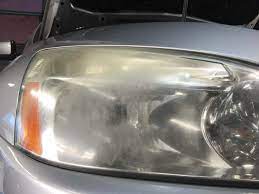There are a few reasons why headlights can get foggy. One reason is because of the humidity in the air, which can condense on the headlight lens and cause it to appear foggy. Another reason could be because of road grime or other contaminants that build up on the lens over time. Headlights can also get Foggy from exposure to UV rays, which causes the plastic lenses to deteriorate and become cloudy. Headlights are incredibly important for drivers. They allow you to see the road in front of you, and they help other drivers see your car. However, headlights tend to get foggy over time due to exposure to UV rays and moisture, which can reduce visibility while driving. How do headlights become cloudy? The lenses on your car’s headlights are made from plastic, so they are susceptible to damage from UV rays. This causes them to break down over time and lose their transparency, making them appear foggy or cloudy.
Headlights get foggy from condensation.
To understand why headlights get foggy, you need to know what condensation is.
Condensation is water vapour in the air that cools and turns into liquid. It can be caused by a change in temperature, or from high humidity. You may have experienced this when you’ve left your drink outside on a cold day—it will have condensation on it because as the drink cools down, the water molecules inside solidify into ice crystals and form droplets of water on top of your glass. This process also happens with warm breath when you exhale: your body heat creates moisture in your mouth and throat which then turns into steam that escapes through your nose or mouth (or both).
This occurs every time someone exhales—the same thing happens when you breathe out onto an icy windowpane as well!
Warm, humid conditions cause condensation on the inside of your headlight lenses.
In warm, humid conditions, condensation occurs when warm air comes in contact with a cold surface. This can cause moisture to form on the inside of your headlights if the headlight lens has been exposed to the elements for too long. It’s important to note that this fog is usually located on the underside of the headlight lens and is not visible from outside of your vehicle. The fog typically dissipates within a few days as it evaporates from its surface.
Heat from your headlights melts frost and fog from the outside of your headlight lenses.
The heat that comes from your headlights melts frost and fog from the outside of your headlight lenses. When you start your car, the headlights begin to radiate heat. This heat can be several times hotter than the temperature inside the headlight and is enough to melt any fog or frost that has collected on your headlight lens.
This is why it’s so important not to leave anything blocking off those lights while they’re on—you want all that warmth getting out!
It can take a few days for the moisture to evaporate.
- It may take a few days for the moisture to evaporate, so don’t drive the vehicle until you’re sure it’s safe.
- Some drivers recommend waiting at least 24 hours before driving your vehicle after removing your headlights from a hot garage or storage unit. If you must drive before that time has passed, be aware that condensation may still be present on the inside of your lights and could cause dangerous glare in front of you as well as oncoming motorists—so be extra cautious!
It’s tempting to think that your headlight fogging is a sign you need new lights, but sometimes it just means you’ve been driving in warm, wet conditions.
Foggy headlights are a common sight on our roads, but if you’re wondering why the beam of light coming from your car is so hazy, it’s tempting to think that your headlight fogging is a sign you need new lights. Headlight haze or fogging can actually be caused by a number of factors—and while some may be temporary and fixable with cleaning, others could signal a bigger problem that requires professional attention.
Headlights emit light through glass lenses, which magnify and focus the beam into one central point. This glass lens can become dirty or contaminated over time, causing the beams to scatter and create an unfocused spot rather than a clear line of light. Foggy headlights can also occur when moisture builds up in the housing around the bulb (known as condensation) while driving in warm wet conditions such as rain or snowfall without using defroster fans appropriately first time out after winter storage maintenance procedures have been completed properly every year before going away again for months – this usually happens when people forget about their vehicles sitting there overnight unprotected from outside elements like wind-blown dirt particles landing directly onto them after being kicked up by other cars passing by on busy city streets during rush hour traffic jams driving home from work at 5pm every day – so make sure yours gets cleaned regularly!

